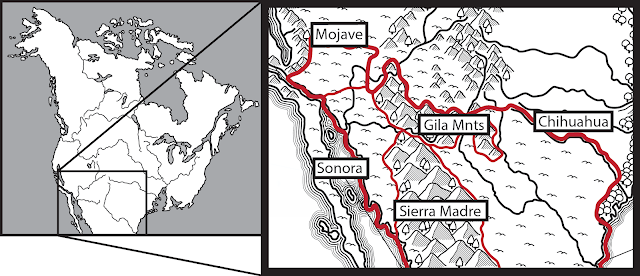GNA - Ecology of the Great Plains
This vast sea of grass stretches from the foothills of the Rocky Mountains in the west to the Mississippi River. Its northern limits are marked by the Saskatchewan River, at which point the landscape is dominated by the rolling forests of the Laurentian Shield and the Mackenzie River valley. In the south, its transition to desert scrubland is marked by the course of the Red River.
The region is semi-arid and temperate, growing more tropical as one moves southeast. This transition is marked by increased precipitation, though across the region most rainfall is between May and July. Both short- and long-term droughts are common. Summers tend to be hot, averaging 35 C in the south and 17 C in the north, while winters are cool, hovering around 15 C in the south and hovering around freezing in the northern portions. That said, the region's flat and open nature can cause large and unpredictable swings in temperature from day to day or week to week. In the west, Chinooks - warm, dry winds - can carry over the mountains giving rise to unseasonably warm weather in cooler months - rising as much as 30 C over the course of a day. In terms of more extreme weather - the region is plagued by wildfires. These occur every 2-3 years on the plains and roughly every eight years in the savannah band that lines the transition to the eastern forests. The plains are also one of the continent's Tornado Alleys, and terrible twisters and windstorms are a common occurrence in late Spring or early Summer.
The Great Plains are a vast, flat, treeless plain - warped only by the presence of rolling hills. In western
areas, tablelands and badlands can be found as the plains meet the swelling foothills of the Rockies. The
northernmost plains are marked by the presence of rocky escarpments, lava-capped mesas, and dike-
formed ridges most common near the small mountains which form islands or pine and fir forest that
thrust eastward into the plains. These forests provide shelter and wood to the plainsmen, who often
spend their summers on the heights. The southern plains are more uniform - its sandy soil is highly
eroded into gentle hills and shallow river valleys.
In terms of plant cover, the plains are dominated by grasses, transitions from scrub and shortgrass in the
west, through tallgrass in the center, and finally a tree and shrub-dotted savannah band on the east and
northeast. These trees grow thickest along streams and other bodies of water where they form thin forest
bands, though in places woody shrubs dominate instead of proper trees.
Much of the native plant life has been replaced by hard, fire-adapted weeds such as buffelgrass and
tumble mustard which relies on the seasonal wildfires for its reproduction. These plants exacerbate the
wildfires endemic to the region, providing tinder to create larger and more frequent fires. Tumbleweeds,
another invasive species, also add to this problem, as huge numbers of the plants can roll into a camp,
burying tents in dry and thorny plants. Fire, once it has caught on such weeds, spreads quickly and can
trap and kill whole herds or destroy homes.
Fearsome Critters: giant nile monitor/megalania, bobcat, coyote/coywolf, lion, cheetah, jackalope, giant constrictor snake, giant catfish.
Big Game: mustang, bison, white-tailed deer, caribou, pronghorn, mule deer, bison, elephant (savannah)
Small Game: badger, beaver, gopher, ground squirrel, mink, muskrat, opossum, prairie dog, raccoon, red fox, shrew, skunk, weasel, vole
Fowl: ring-necked pheasant, sharp-tailed grouse, prairie chicken, gray partridge, scaled quail, wild turkey, mourning dove, duck (various), goose (various), trumpeter swan
Cold Water Fish: trout, salmon, northern pike, walleye, smallmouth bass, yellow perch
Warm Water Fish: catfish, largemouth bass, crappie, white bass, striped bass, wiper, saugeye
Pests: locust swarms, ant/termite swarms, giant grasshopper, giant leech, giant tick
This region is the domain of the plainsmen - disparate clans of sheep and cattle-driving nomads who live in yurts carried in great wagons, carts, or travois. These groups are scattered far across the plains with much of the region having a population density of 5 per square mile or less. Even in the grass plains, agriculture is practiced, but this is universally done via irrigation along major rivers or lakes. In these areas, various cereal grains including wheat, alfalfa, barley, hay, and corn are grown. Cotton is also produced in small amounts in the central and southern plains.
Agriculture becomes more dominant on the savannah belt, the southern portion of which is in turn part of the Corn Belt - the most productive cropland for corn and soybean on the continent. Here the population is denser, rising to about 30 people per square mile. Access to land is contested by nomads and farmers - a source of much tension. Common crops include potatoes, beans, sugar beats, various cereal crops (especially corn), canola, and sunflower. Farmed animals include chickens, hogs, and both beef and dairy cattle.










Comments
Post a Comment